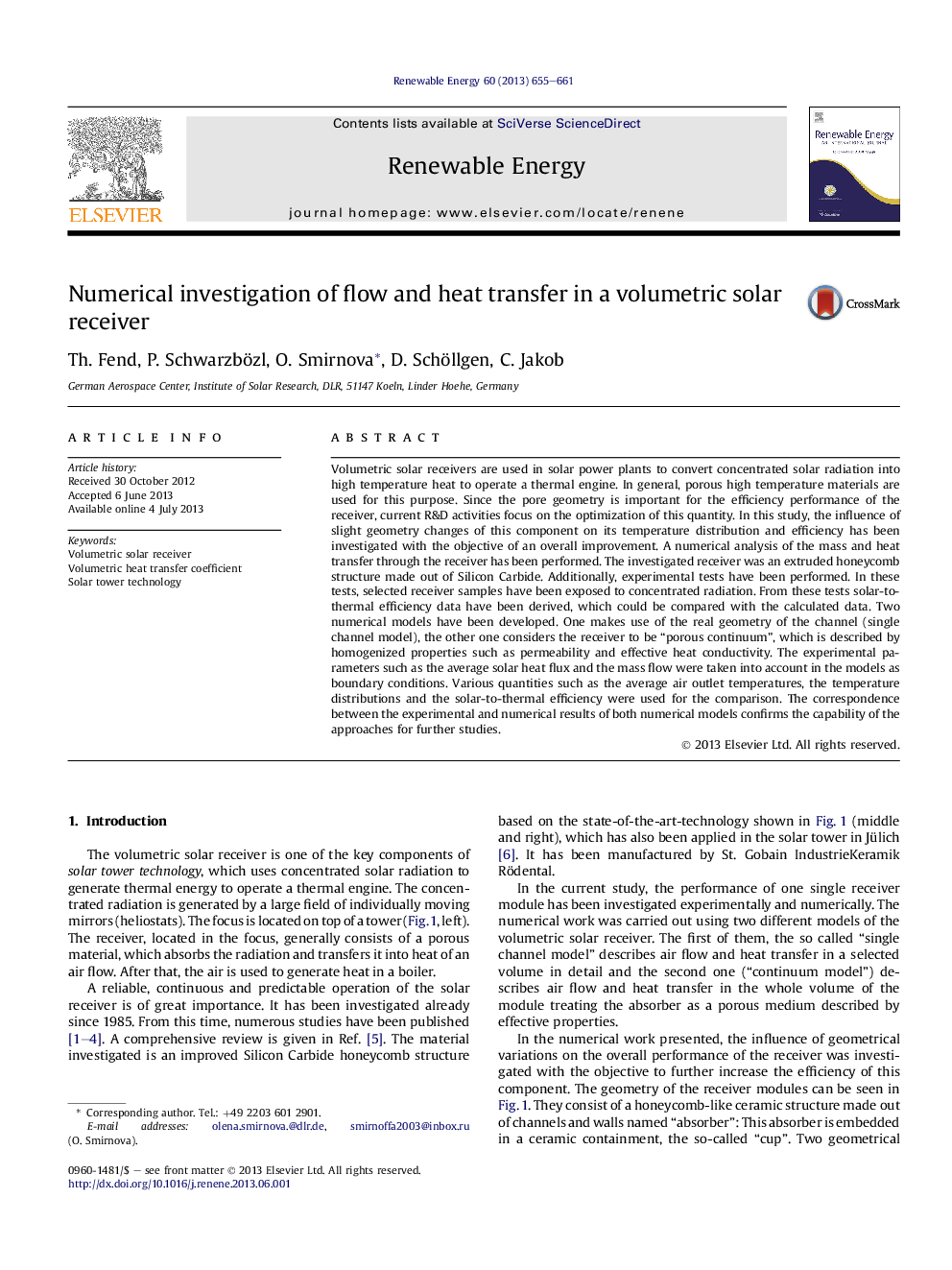| کد مقاله | کد نشریه | سال انتشار | مقاله انگلیسی | نسخه تمام متن |
|---|---|---|---|---|
| 6769379 | 512474 | 2013 | 7 صفحه PDF | دانلود رایگان |
عنوان انگلیسی مقاله ISI
Numerical investigation of flow and heat transfer in a volumetric solar receiver
ترجمه فارسی عنوان
بررسی عددی جریان و انتقال گرما در یک گیرنده خورشیدی حجمی
دانلود مقاله + سفارش ترجمه
دانلود مقاله ISI انگلیسی
رایگان برای ایرانیان
کلمات کلیدی
گیرنده خورشیدی حجمی، ضریب انتقال حرارت حرارت فن آوری برج خورشیدی،
ترجمه چکیده
گیرنده های خورشیدی حجمی در نیروگاه های خورشیدی برای تبدیل پرتوهای متمرکز خورشیدی به حرارت حرارت بالا برای استفاده از موتور حرارتی استفاده می شوند. به طور کلی، مواد متخلخل با درجه حرارت بالا برای این منظور استفاده می شود. از آنجا که هندسه حفره برای عملکرد کارایی گیرنده اهمیت دارد، فعالیت های تحقیق و توسعه فعلی بر روی بهینه سازی این مقدار تمرکز می کنند. در این مطالعه اثر تغییرات هندسی جزئی این مولفه در توزیع و کارایی آن با هدف بهبود کلی بررسی شده است. تجزیه و تحلیل عددی از انتقال جرم و گرما از طریق گیرنده انجام شده است. گیرنده مورد بررسی یک ساختار لانه زنبوری اکسترود شده ساخته شده از سیلیکون کاربید بود. علاوه بر این، آزمایش های تجربی انجام شده است. در این آزمایشات، نمونه گیرنده انتخاب شده به تابش متمرکز شده است. از این آزمایشات داده های بهره وری از خورشید به حرارت گرفته شده است که می تواند با داده های محاسبه شده مقایسه شود. دو مدل عددی توسعه یافته اند. یکی از هندسه واقعی کانال (مدل کانال تک کانال) استفاده می کند، یکی دیگر از گیرنده ها را متوازن متخلخل می داند که توسط ویژگی های همگن شده مانند نفوذ پذیری و هدایت مؤثر حرارت توصیف می شود. پارامترهای تجربی مانند متوسط شار حرارت خورشیدی و جریان جرم در مدل ها به عنوان شرایط مرزی مورد توجه قرار گرفتند. مقادیر مختلف مانند دمای متوسط خروجی هوا، توزیع دما و بازده خورشیدی به حرارتی برای مقایسه استفاده شد. مکاتبات بین نتایج تجربی و عددی هر دو مدل عددی، توانایی رویکردهای مطالعات بیشتر را تأیید می کند.
موضوعات مرتبط
مهندسی و علوم پایه
مهندسی انرژی
انرژی های تجدید پذیر، توسعه پایدار و محیط زیست
چکیده انگلیسی
Volumetric solar receivers are used in solar power plants to convert concentrated solar radiation into high temperature heat to operate a thermal engine. In general, porous high temperature materials are used for this purpose. Since the pore geometry is important for the efficiency performance of the receiver, current R&D activities focus on the optimization of this quantity. In this study, the influence of slight geometry changes of this component on its temperature distribution and efficiency has been investigated with the objective of an overall improvement. A numerical analysis of the mass and heat transfer through the receiver has been performed. The investigated receiver was an extruded honeycomb structure made out of Silicon Carbide. Additionally, experimental tests have been performed. In these tests, selected receiver samples have been exposed to concentrated radiation. From these tests solar-to-thermal efficiency data have been derived, which could be compared with the calculated data. Two numerical models have been developed. One makes use of the real geometry of the channel (single channel model), the other one considers the receiver to be “porous continuum”, which is described by homogenized properties such as permeability and effective heat conductivity. The experimental parameters such as the average solar heat flux and the mass flow were taken into account in the models as boundary conditions. Various quantities such as the average air outlet temperatures, the temperature distributions and the solar-to-thermal efficiency were used for the comparison. The correspondence between the experimental and numerical results of both numerical models confirms the capability of the approaches for further studies.
ناشر
Database: Elsevier - ScienceDirect (ساینس دایرکت)
Journal: Renewable Energy - Volume 60, December 2013, Pages 655-661
Journal: Renewable Energy - Volume 60, December 2013, Pages 655-661
نویسندگان
Th. Fend, P. Schwarzbözl, O. Smirnova, D. Schöllgen, C. Jakob,
